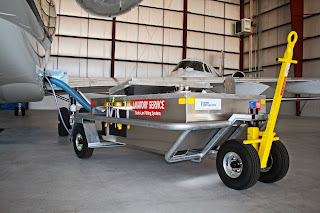Strategies for Avoiding GSE Congestion on the Apron
Any airport’s apron is necessarily a busy place. In addition to the
massive aircraft arriving and departing, there are entire fleets of
ground support equipment (GSE) vehicles zipping around to service them.
Refueling vehicles, aircraft tugs,
tractors pulling a string of baggage carts, deicers in winter, all of
the lav and food service carts, plus ground crew on foot, are all active
on the apron. Not to mention that on any given day there are many
millions of dollars represented on the apron, not just in aircraft on
the ground, but in money lost to delays.
Ground crews face high expectations in a busy workspace to work quickly, safely, and to high standards. When there’s that much going on, with strict schedules to keep and so many moving parts, a lapse in oversight, management, or preparation can result in costly delays. It can also have more dire consequences by increasing the risk of accidents significantly. As such, avoiding GSE congestion should always be a priority.
Implement Fleet Tracking Software
The implementation of fleet management programs and software has proven to be a major benefit throughout the aviation community. Monitoring a fleet with technology such as a telematics program allows the tracking of every aircraft tug and cargo loader. That allows crew managers to more effectively manage and optimize the use of all the GSE in their fleet. Some of those telematics programs can even measure and record impact and collision data for a quick response.
Use Maintenance Tracking Technology
An additional benefit provided by many fleet management systems is that they greatly assist with the accuracy of GSE maintenance schedules. If that’s not a feature of telematics or another management system already in place, any GSE fleet manager should set up a dedicated strategy for maintenance scheduling and alerts. Software that tracks maintenance scheduling and alerts teams to potential faults or needed replacements can save a whole lot of money by mitigating GSE mechanical issues before they become problems. Functioning GSE is also far less likely to contribute to congestion!
Update Operator Training and Access Programs
The appropriate and consistently updated training of operators is one of those features of airside crew operation that’s often emphasized but can’t be overstated. There’s arguably nothing more crucial to the smooth operation of a ground crew than thorough and up-to-date training. In addition, institute an access program—only allowing those with the appropriate training and certification access to their specific GSE. That reduces the risk of crew taking out GSE they’re not trained on for convenience or because it’s similar to what they operate.
Prioritize Communication and Collaboration, Such as GSE Pooling
In addition to telematics, fleet management, and training and access protocols, GSE pooling has become incredibly popular throughout the aviation industry. It improves efficiency, reduces the presence of unnecessary GSE on the apron, saves fuel, and saves money. A less often cited but nevertheless beneficial element is that it improves communication between ground crews. That centralization of GSE and improved communication between the crews also contributes to improved communication with airport management. All of which means smoother airside operation and less risk of congestion on the apron.
About AERO Specialties
AERO Specialties is an industry-leading aviation ground support equipment (GSE) provider offering GSE that’s well-known for optimized performance, safety, and reliability. Their customers, both civilian and military, at corporate airports, FBOs, or private airports, rely on AERO Specialties for the highest quality GSE, new, used, and refurbished. As an additional assurance of excellence, AERO Specialties trains each one of the members of their team, familiarizing them thoroughly with every piece of GSE they offer. That means whatever GSE you need, from a powerful, safe aircraft tow tractor, to a set of multicolored LED marshalling wands, you can trust AERO Specialties.
Take your aviation business to greater heights with GSE from AERO Specialties, at Aerospecialties.com
Ground crews face high expectations in a busy workspace to work quickly, safely, and to high standards. When there’s that much going on, with strict schedules to keep and so many moving parts, a lapse in oversight, management, or preparation can result in costly delays. It can also have more dire consequences by increasing the risk of accidents significantly. As such, avoiding GSE congestion should always be a priority.
Implement Fleet Tracking Software
The implementation of fleet management programs and software has proven to be a major benefit throughout the aviation community. Monitoring a fleet with technology such as a telematics program allows the tracking of every aircraft tug and cargo loader. That allows crew managers to more effectively manage and optimize the use of all the GSE in their fleet. Some of those telematics programs can even measure and record impact and collision data for a quick response.
Use Maintenance Tracking Technology
An additional benefit provided by many fleet management systems is that they greatly assist with the accuracy of GSE maintenance schedules. If that’s not a feature of telematics or another management system already in place, any GSE fleet manager should set up a dedicated strategy for maintenance scheduling and alerts. Software that tracks maintenance scheduling and alerts teams to potential faults or needed replacements can save a whole lot of money by mitigating GSE mechanical issues before they become problems. Functioning GSE is also far less likely to contribute to congestion!
Update Operator Training and Access Programs
The appropriate and consistently updated training of operators is one of those features of airside crew operation that’s often emphasized but can’t be overstated. There’s arguably nothing more crucial to the smooth operation of a ground crew than thorough and up-to-date training. In addition, institute an access program—only allowing those with the appropriate training and certification access to their specific GSE. That reduces the risk of crew taking out GSE they’re not trained on for convenience or because it’s similar to what they operate.
Prioritize Communication and Collaboration, Such as GSE Pooling
In addition to telematics, fleet management, and training and access protocols, GSE pooling has become incredibly popular throughout the aviation industry. It improves efficiency, reduces the presence of unnecessary GSE on the apron, saves fuel, and saves money. A less often cited but nevertheless beneficial element is that it improves communication between ground crews. That centralization of GSE and improved communication between the crews also contributes to improved communication with airport management. All of which means smoother airside operation and less risk of congestion on the apron.
About AERO Specialties
AERO Specialties is an industry-leading aviation ground support equipment (GSE) provider offering GSE that’s well-known for optimized performance, safety, and reliability. Their customers, both civilian and military, at corporate airports, FBOs, or private airports, rely on AERO Specialties for the highest quality GSE, new, used, and refurbished. As an additional assurance of excellence, AERO Specialties trains each one of the members of their team, familiarizing them thoroughly with every piece of GSE they offer. That means whatever GSE you need, from a powerful, safe aircraft tow tractor, to a set of multicolored LED marshalling wands, you can trust AERO Specialties.
Take your aviation business to greater heights with GSE from AERO Specialties, at Aerospecialties.com




Comments
Post a Comment